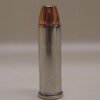Keeebs
Member
- Joined
- Feb 2, 2020
- Messages
- 20
Hello, I'm new to reloading. I feel I have the basics down, but I'm not sure I'm crimping correctly. I'm using LEE 38/357 4 die set which has a crimper. I've followed the instructions and I'm set to "light crimp". I can't see the crimp, feel the crimp or measure the crimp. Is there a trick to test if you have enough crimp? I'm not sure if I even have a crimp at all, I don't feel any resistance when the bullet goes into the crimp die.
357 mag revolver.
Hornady 158gr XTP
Powder: 2400
13.7gr, 14.0gr, 14.3gr (I'm working up a load)
Picture on the Left Federal factory load, Right My Load.
357 mag revolver.
Hornady 158gr XTP
Powder: 2400
13.7gr, 14.0gr, 14.3gr (I'm working up a load)
Picture on the Left Federal factory load, Right My Load.








